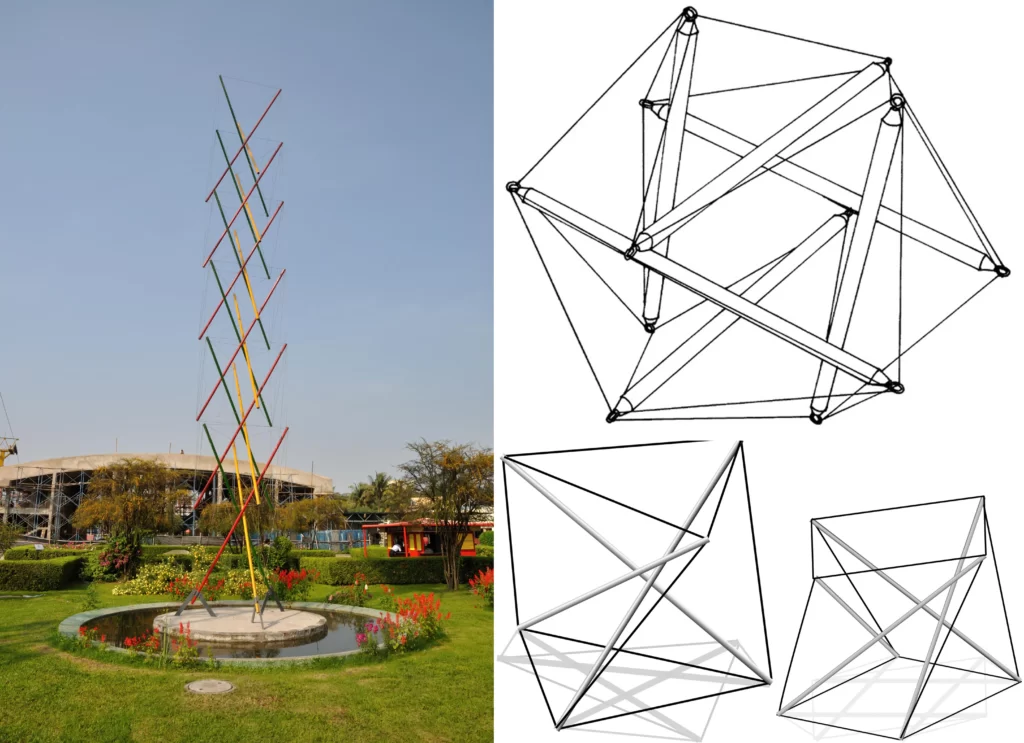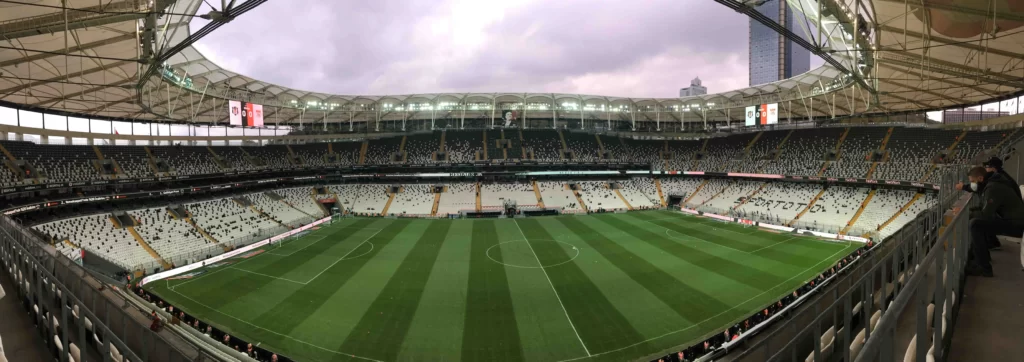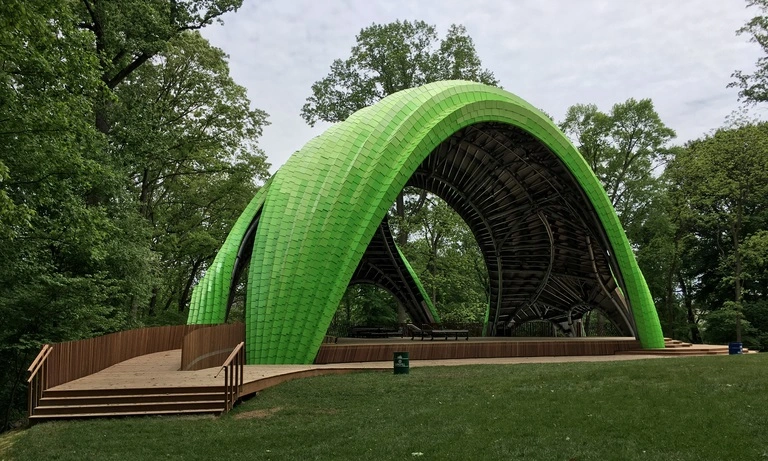If you want to know about the Islamic architecture or staircase design or landscape garden, please click the link.
Introduction
Tensegrity structures are architectural designs that rely on the balance between tension and compression to create stable and efficient structures. They are becoming increasingly popular in architecture due to their unique properties and advantages over traditional building methods.

Tensegrity structures are known for their efficiency, as they can support large amounts of weight while using minimal materials. They are also extremely strong and flexible, allowing for a wide range of design possibilities.
1) History of tensegrity structures
Tensegrity structures have their origins in the mid-20th century and were developed by a number of architects and designers who were interested in exploring new approaches to structural design. Two of the most notable figures in the early development of tensegrity structures were Buckminster Fuller and Kenneth Snelson.
Fuller was an American architect and engineer who is perhaps best known for his geodesic dome designs. In the late 1940s and early 1950s, Fuller began experimenting with tensegrity structures, which he called “continuous tension, discontinuous compression” structures.
He saw these structures as a way to create lightweight, efficient designs that could be used in a variety of applications, from architecture to transportation.
Snelson was also an American artist and sculptor who worked closely with Fuller and was instrumental in the development of tensegrity structures. In 1948, Snelson created his first tensegrity sculpture, which he called “X-Piece.”
This sculpture consisted of a series of rods and cables arranged in a self-supporting, three-dimensional configuration. Snelson continued to explore tensegrity structures throughout his career and became known for his innovative designs and sculptures.
Other key players in the development of tensegrity structures include Konrad Wachsmann, a German-American architect who worked with Fuller on several projects, and David Georges Emmerich, a French architect who developed a number of tensegrity-inspired designs in the 1970s and 1980s.
Together, these architects and designers paved the way for the widespread use of tensegrity structures in architecture and other fields.
2) Principles of tensegrity structures
Tensegrity structures are characterized by a balance between tension and compression. In these structures, tension elements such as cables or wires are held in place by compression elements such as rods or struts.

The resulting structure is one in which the compression elements do not touch each other, but are instead separated by the tension elements. This creates a structure that is incredibly stable and efficient, as it can support a great deal of weight while using minimal materials.
There are several different types of tensegrity structures, each with their own unique properties. One of the most common types is the rod-and-cable tensegrity structure, in which a series of rods or struts are connected by cables or wires in a self-supporting, three-dimensional configuration.
This type of tensegrity structure is often used in architecture, as it allows for the creation of complex, organic shapes that would be difficult to achieve with traditional building methods.
Another type of tensegrity structure is the tendon-and-ligament tensegrity structure, in which the tension elements are made of flexible materials such as fabric or mesh. This type of structure is often used in medical applications, such as in the design of artificial muscles or tissue scaffolds.
Tensegrity structures can also be categorized based on the number of compression and tension elements they contain. Some structures are composed primarily of tension elements, while others have a more even balance between compression and tension.
The properties of these structures can vary widely depending on their design and composition, making them an incredibly versatile tool for architects, engineers, and designers.
3) Advantages of tensegrity structures in architecture
Tensegrity structures offer a number of advantages over traditional architectural design approaches, including:
- Lightweight nature: Tensegrity structures are incredibly lightweight, as they use minimal materials to create stable and efficient designs. This makes them ideal for applications where weight is a critical factor, such as in the design of bridges, roofs, or other large-scale structures.
- Cost-effectiveness: Tensegrity structures can be highly cost-effective, as they require fewer materials and can be constructed more quickly than traditional building methods. This makes them an attractive option for projects with tight budgets or timelines.
- Aesthetic appeal: Tensegrity structures can be used to create striking, visually appealing designs that are not possible with traditional building methods. This makes them a popular choice for architects and designers who want to create unique, eye-catching structures.
- Versatility: Tensegrity structures can be used in a wide range of applications, from small-scale sculptures to large-scale buildings. This versatility makes them an attractive option for architects and designers who want to experiment with new design approaches.
Real-world examples of tensegrity structures in architecture include:
- The Eden Project in Cornwall, UK, which features a series of biomes made of steel and ETFE (ethylene tetrafluoroethylene) fabric. The biomes are suspended from a series of steel cables in a tensegrity-style design.

- The Alamillo Bridge in Seville, Spain, which was designed by architect Santiago Calatrava and features a series of tension cables that support the bridge deck.

- The Montreal Biosphere, a museum in Canada designed by architect Buckminster Fuller. The museum features a series of tensegrity-style geodesic domes that create a striking, visually appealing design.

- The Vodafone Arena in Istanbul, Turkey, which features a series of steel cables that create a tensegrity-style roof over the stadium.

Overall, tensegrity structures offer a number of advantages in architectural design and have been used in a wide range of applications around the world.
As architects and designers continue to experiment with new materials and design approaches, it is likely that tensegrity structures will become an increasingly popular tool in the creation of innovative, efficient, and visually stunning buildings and structures.
4) Challenges of designing and building tensegrity structures
Designing and constructing tensegrity structures can be challenging due to their unique properties and complex geometries. Some of the main challenges faced by architects and builders when working with tensegrity structures include:
- Complex geometries: Tensegrity structures can be incredibly complex, with intricate patterns of cables and struts that must be carefully engineered to ensure stability and safety. This requires a high degree of precision and expertise in design and construction.
- Precise engineering: The tension and compression elements in a tensegrity structure must be precisely balanced in order to create a stable and efficient design. This requires a deep understanding of engineering principles and the ability to model and simulate the structure in advance of construction.
- Maintenance: Tensegrity structures can be difficult to maintain due to their unique design and the need for specialized equipment and expertise. This can be particularly challenging for large-scale structures or those located in remote or difficult-to-access locations.
There have been several examples of tensegrity structures that have faced challenges during construction or maintenance. One notable example is the Chrysalis Amphitheater in Merriweather Park at Symphony Woods in Maryland, USA.

The structure, which was designed by architect Marc Fornes, features a complex tensegrity-style design with a series of steel pipes and cables that support a lightweight fabric canopy. During construction, the fabric canopy was damaged by high winds, leading to delays and additional costs.
Another example is the Spire London tower in London, UK, which features a complex tensegrity-style design with a series of steel cables that support the building’s tapered shape. During construction, the project faced significant delays due to the complexity of the design and the need for precise engineering and construction techniques.
Overall, while tensegrity structures offer a range of benefits in architectural design, they also present unique challenges that must be carefully considered and addressed during the design and construction process. With careful planning and execution, however, these structures can offer striking, innovative solutions to a wide range of architectural challenges.
5) Sustainability and tensegrity structures
Tensegrity structures offer several sustainability benefits in architecture. By reducing the amount of materials required for construction, they can help to lower a building’s carbon footprint and reduce the environmental impact of construction. Additionally, the lightweight nature of tensegrity structures can help to reduce the amount of energy required for transportation and installation.
Tensegrity structures can also help to improve a building’s energy efficiency. The efficient use of materials in tensegrity structures means that they can be designed with thinner walls, allowing for increased natural light and ventilation. This can help to reduce the amount of energy required for lighting and climate control, as well as improve the overall comfort of the building’s occupants.
Another sustainability benefit of tensegrity structures is their ability to adapt to changing environmental conditions. Because of their lightweight and flexible nature, tensegrity structures can respond to changes in wind and temperature, helping to minimize the need for mechanical systems to regulate the building’s climate.
Finally, the use of tensegrity structures can also help to create more resilient buildings that are better able to withstand natural disasters such as earthquakes, hurricanes, and floods. This can help to reduce the environmental impact of building damage and reconstruction, while also improving the safety and well-being of the building’s occupants.
Overall, tensegrity structures offer several sustainability benefits in architecture. By reducing a building’s carbon footprint, improving its energy efficiency, and creating more resilient structures, tensegrity structures can help to create a more sustainable built environment. As the focus on sustainability in architecture continues to grow, it is likely that we will see an increasing use of tensegrity structures in building design and construction.
6) Future of tensegrity structures in architecture
Tensegrity structures have already gained popularity in architecture and their potential for the future is vast. With the growing focus on sustainability and innovative design, it is likely that tensegrity structures will become even more prevalent in architecture in the future.
Here are some potential reasons why:
- Technological advancements: As technology continues to improve, architects and builders will have access to new tools and materials that can help to make tensegrity structures even more efficient and sustainable. For example, the use of digital modeling tools and advanced engineering software can help to optimize the design and construction process for tensegrity structures.
- Sustainable design: As the focus on sustainability in architecture continues to grow, more and more architects and builders will be looking for innovative ways to reduce a building’s environmental impact. Tensegrity structures offer a unique solution to this challenge, as they can help to reduce the amount of materials required for construction, improve energy efficiency, and create more resilient structures.
- Aesthetics: Tensegrity structures offer a unique aesthetic appeal that is becoming increasingly popular in modern architecture. With their intricate patterns of cables and struts, tensegrity structures can create striking visual effects that are both functional and beautiful.
In terms of the latest trends and innovations in tensegrity structure design and construction, there are several exciting developments to keep an eye on.
For example, researchers are exploring new ways to use tensegrity structures in robotics and other applications, while architects are experimenting with new materials and construction techniques to create larger and more complex structures.
There is also a growing interest in the use of tensegrity structures in temporary and mobile architecture, such as pop-up shops, festival installations, and disaster relief shelters.
Overall, the potential for tensegrity structures in architecture is vast, and we are likely to see continued innovation and experimentation in this area in the years to come. Whether it is through new materials, technologies, or design techniques, tensegrity structures offer a unique solution to the challenges of sustainable and innovative architecture.
7) Conclusion
In summary, tensegrity structures are a type of architectural design that relies on the balance between tension and compression to create stable and efficient structures. Tensegrity structures offer several benefits in architecture, including their lightweight nature, cost-effectiveness, and aesthetic appeal. They can also help to reduce a building’s carbon footprint, improve its energy efficiency, and create more resilient structures that can withstand natural disasters.
Despite the challenges involved in designing and constructing tensegrity structures, they offer a unique solution to the challenges of sustainable and innovative architecture.
With advances in technology and engineering, tensegrity structures have the potential to become even more prevalent in architecture in the future. Architects and builders can learn more about tensegrity structures and their applications in architecture to stay ahead of the curve and incorporate this innovative design approach into their projects.
In conclusion, tensegrity structures offer a unique and innovative solution to the challenges of modern architecture. Their potential for sustainability, energy efficiency, and aesthetic appeal make them an exciting and valuable addition to the field of architecture.
As the focus on sustainability and innovative design continues to grow, it is important for architects and builders to stay up-to-date on the latest trends and innovations in tensegrity structure design and construction.